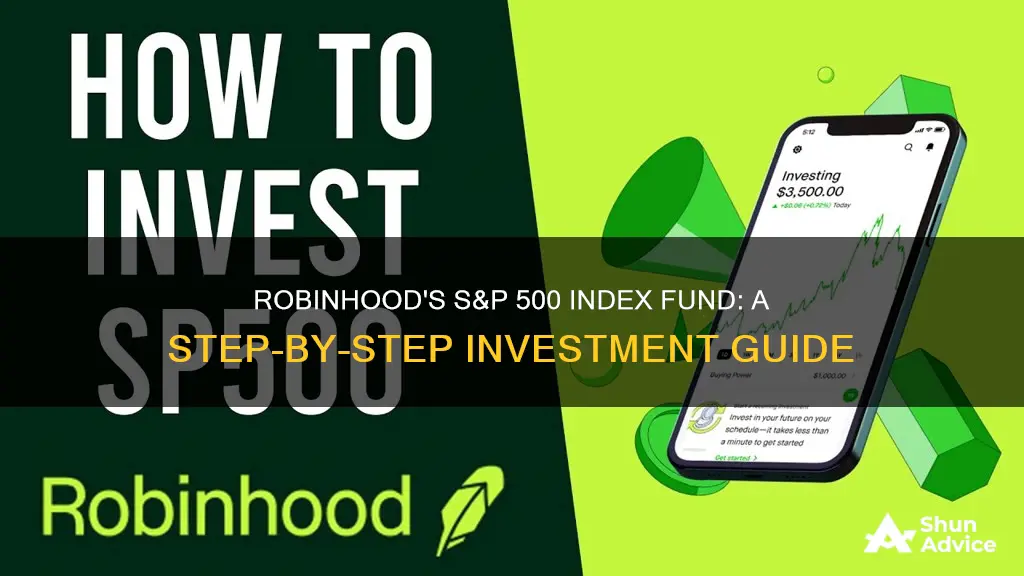
The S&P 500 is a stock market index that tracks the performance of 500 of the largest U.S. public companies by market capitalization. It is considered a good investment option as it provides instant diversification and lower risk compared to investing in individual stocks. While you cannot invest directly in the S&P 500 index itself, you can gain exposure to the index by investing in index funds or exchange-traded funds (ETFs) that track it.
To invest in the S&P 500 using Robinhood, you would typically use an S&P 500 ETF since Robinhood is a trading platform that allows you to buy and sell securities throughout the day. Here are the steps you can follow:
1. Open a brokerage account with Robinhood if you don't already have one.
2. Decide on an S&P 500 ETF that suits your investment goals and risk tolerance. Popular options include the SPDR S&P 500 ETF (SPY), iShares Core S&P 500 ETF (IVV), and Vanguard S&P 500 ETF (VOO).
3. Review the performance, fees, and other relevant information about the chosen ETF.
4. Purchase the desired number of shares of the S&P 500 ETF through your Robinhood account.
Remember to consider the advantages and disadvantages of investing in the S&P 500, such as the exposure to large-cap companies and the lack of international companies in the index. Ensure that your overall investment portfolio is well-diversified and aligns with your financial goals and risk tolerance.
What You'll Learn

Opening an investment account
To invest in the S&P 500, you'll first need to open an investment account. You can use this account to buy and hold your investments, including any assets linked to the S&P 500 index.
There are several options for opening an investment account. You can use an online broker, an investment app, or a robo-advisor. Online brokers and investment apps tend to have low fees, and some even offer zero trading commissions. Robo-advisors, on the other hand, will automatically manage your investments for you, but you won't be able to choose the specific assets in which your money is invested.
Once you've decided on the type of account you want to open, you can compare different brokers, apps, or robo-advisors based on their fees, investment minimums, and the funds they offer. It's important to consider the expense ratio, or the ongoing fee paid to the fund manager, as well as any other applicable loads or commissions.
When choosing an online broker or investment app, you may also want to consider the convenience of using their platform and whether they offer fractional shares. Fractional shares allow you to invest in a company without having to purchase a full share, which can be more affordable for some investors.
After you've compared your options and chosen a broker, app, or robo-advisor, you can proceed to open your investment account by following the instructions provided by your chosen platform. This usually involves providing personal information and funding your account.
Once your investment account is open and funded, you can start investing in the S&P 500 by purchasing shares of an S&P 500 index fund or exchange-traded fund (ETF). These funds aim to replicate the returns of the S&P 500 by tracking it, offering investors exposure to a diverse range of S&P 500 companies.
Remember to consider the fees, performance, and investment strategy of the specific fund before making your investment decision. Diversification is also important, so make sure you have a mix of large-cap, mid-cap, and small-cap stocks, as well as international stocks and other asset types, in your portfolio.
Debt Funds on Zerodha: A Step-by-Step Investment Guide
You may want to see also

Investing in an S&P 500 ETF
ETFs are a popular investment choice because each ETF is listed on an exchange, which allows it to be traded at any time the market is open. They also often have a low cost of management, especially when tracking a market index such as the S&P 500.
- Open an investment account: If you don't already have a brokerage account, you'll need to open one to buy investments. You can use the money you deposit into the brokerage account to purchase S&P 500 stocks or funds, which will then be held within that account.
- Choose an S&P 500 ETF: There are many S&P 500 ETFs to choose from, such as the SPDR S&P 500 ETF Trust and the iShares Core S&P 500 ETF. You can search for these funds through your online broker or investment app.
- Review the ETF: Before investing, review the ETF's fact sheet, performance, expense ratio, and the amount of capital you have to invest.
- Buy the ETF: You can buy a single share or multiple shares of the ETF through your brokerage account.
It is important to note that the S&P 500 only consists of 500 large-cap stocks, so investors should ensure they have stocks of mid- and small-cap companies, as well as other types of assets like bonds, elsewhere in their portfolio.
Energy Funds: A Smart Investment for Your Future
You may want to see also

Investing in an S&P 500 index fund
The S&P 500 is a stock market index that tracks the performance of 500 of the largest U.S. public companies by market capitalization. The S&P 500 represents approximately 80% of available U.S. market capitalization.
How to invest in the S&P 500
To invest in the S&P 500, investors can gain exposure through discount brokers with commission-free trading. S&P 500 index funds trade through brokers and discount brokers and may be accessed directly from the fund companies. Investors may also access ETFs and mutual funds through employer 401(k) programs, individual retirement accounts (IRA), or robo-advisor platforms.
Different ways to invest in the S&P 500
There are pros and cons to buying the S&P 500 via exchange-traded funds (ETFs) or another type of index fund.
Exchange-traded funds (ETFs)
An exchange-traded fund (or ETF) is a basket of securities, like stocks or bonds, that can be traded like a stock throughout the day. ETFs can consist of hundreds or even thousands of stocks. They typically aim to deliver returns that match the overall market or a certain part of it. They tend to have low fees compared to mutual funds, especially if they're passively managed.
An S&P 500 ETF tracks the performance of the index and allows investors to buy shares of the overall index, which is a good way to diversify a portfolio.
Index funds
An index fund tracks a group of securities, like stocks, bonds, or commodities. Of the many types of investments out there, these are good options for investors who don't want to select individual companies to buy stocks in.
A S&P 500 index fund passively tracks the S&P 500 and allows investors to buy shares of the total basket of stocks.
How to buy index funds
You can now invest in the S&P 500 easily online, including via popular brokerages like Fidelity and newer trading apps like Robinhood. Investment accounts may be geared specifically toward retirement, like an individual retirement account (IRA) or a taxable brokerage account to invest towards other goals, like a down payment.
Another option is robo-advisors, which will automatically rebalance your money for you. If you're buying a mutual fund, you can also buy it directly from the firm, like Vanguard, though this method is not as common.
In conclusion, investing in an S&P 500 index fund is a good option for investors looking to diversify their portfolios at a low cost.
Unlock Real Estate Investing Using Retirement Funds
You may want to see also

Buying S&P 500 futures
S&P 500 futures are a type of derivative contract that provides buyers with an investment price based on the expected future value of the S&P 500 Index. They are a way to invest in the performance of the S&P 500 without buying the index itself. Futures are contracts to buy an asset at a specific price on a future date, allowing investors to speculate on future price movements.
S&P 500 futures are traded on the Chicago Mercantile Exchange (CME) under the ticker symbol ES. They are available in two sizes: E-mini contracts, and micro E-mini contracts, which are one-tenth the value of E-mini contracts. E-mini contracts are one-fifth the size of the now-delisted standard S&P futures contract.
The "E" in E-mini stands for electronic, meaning it is traded electronically. This makes it a very efficient method of trading, more so than the open outcry system. E-mini contracts are also very popular, with trading volumes significantly greater than the standard contracts.
S&P 500 futures are cash-settled, and the CME introduced the first standard-sized S&P 500 futures contract in 1982. This contract was delisted in September 2021, but E-mini and micro E-mini contracts are still available for trade.
E-mini S&P 500 futures are quarterly contracts that expire in March, June, September, and December. They are listed for nine quarters consecutively, along with three more December contract months.
S&P 500 futures are considered a complex financial instrument and are generally only used by experienced investors. They are also a speculative investment instrument, often used by advanced individual investors and fund managers.
Invest 529 Funds: Strategies for Maximizing College Savings
You may want to see also

Buying individual stocks
While it is not possible to buy the S&P 500 itself on Robinhood, you can buy individual stocks of the companies listed on the index.
To buy stocks on Robinhood, you will need a Robinhood investing account. You can then select the stock you want to buy from the stock's detail page, where you will be able to view its historical performance, analyst ratings, company earnings, and other helpful information.
You can then select 'Trade' and 'Buy' (or just 'Buy' if you don't currently own the stock). You will then be asked to enter the amount you would like to purchase in dollars or shares. You can also select another order type, such as a limit order, which is the default during extended hours.
After reviewing your order, you can submit it by swiping up.
It is worth noting that the default buy order is for a number of shares or a dollar amount of the specified stock. Also, the last traded price will not necessarily be the price that your buy order will be executed at.
Best Debt Funds to Invest in Amid Rising Rates
You may want to see also
Frequently asked questions
The S&P 500 is a stock market index that tracks the performance of 500 of the largest U.S. public companies by market capitalization. It gives investors a snapshot of how these companies are performing as a group.
Investing in the S&P 500 gives you exposure to some of the world's most dynamic companies, like Apple, Amazon, and Microsoft. It also offers consistent long-term returns and removes the need for intricate analysis of individual stocks.
The S&P 500 is dominated by large-cap companies, so it has limited exposure to small- and mid-cap stocks with high growth potential. It also carries the risks inherent in equity investing, such as volatility and downside risk, and only includes U.S. companies.







